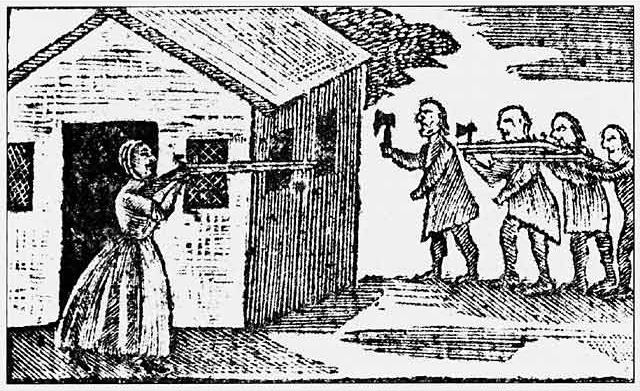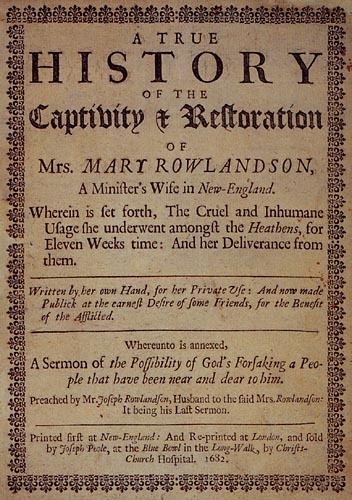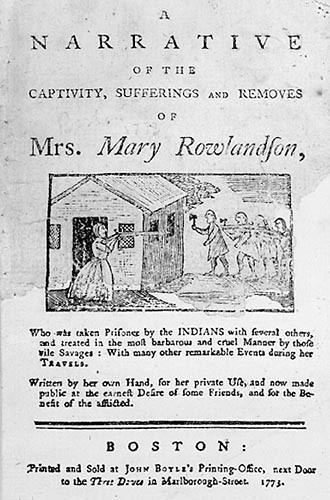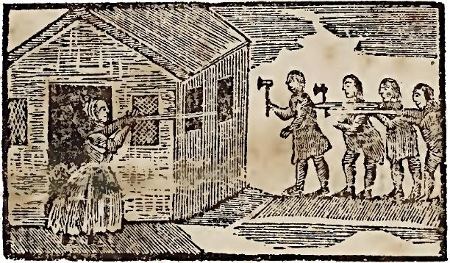Occupation American colonist Name Mary Rowlandson | Parents John White, Joan Bailey | |
 | ||
Born c. 1637 Somersetshire, England Children Sarah Rowlandson, Mary Rowlandson, Joseph Rowlandson Spouse Samuel Talcott (m. 1679), Joseph Rowlandson (m. 1656) Books A Narrative of the Captivity, Captivity and Restoration, The Account of Mary Ro, The Captive: The True, A True History of the Capti Similar People Anne Bradstreet, James A Henretta, Thomas Slaughter, Horace Kephart | ||
Mary rowlandson
Mary Rowlandson, née White, later Mary Talcott (c. 1637 – January 5, 1711) was a colonial American woman who was captured by Native Americans during King Philip's War and held for 11 weeks before being ransomed. In 1682, six years after her ordeal, The Sovereignty and Goodness of God: Being a Narrative of the Captivity and Restoration of Mrs. Mary Rowlandson was published. This text is considered a seminal American work in the literary genre of captivity narratives. It went through four printings in 1682 and garnered readership both in the New England colonies and in England, leading it to be considered by some the first American "bestseller".
Contents
- Mary rowlandson
- Mary rowlandson captivity narrative
- Biography
- The Sovereignty and Goodness of God
- Fear and revulsion
- Biblical Content and Ministerial Influences
- References

Mary rowlandson captivity narrative
Biography

Mary White was born c. 1637 in Somerset, England. The family left England sometime before 1650, settled at Salem in the Massachusetts Bay Colony and moved in 1653 to Lancaster, on the Massachusetts front. There she married Reverend Joseph Rowlandson, the son of Thomas Rowlandson of Ipswich, Massachusetts, in 1656. Four children were born to the couple between 1658 and 1669, with their first daughter dying young.

At sunrise on February 10, 1675, during King Philip's War, Lancaster came under attack by Narragansett, Wampanoag and Nashaway/Nipmuc Indians. During the attack, which was anticipated by residents including Mary's husband, Joseph, the Native American raiding party killed 13 people, while at least 24 were taken captive, many of them injured. Rowlandson and her three children, Joseph, Mary, and Sarah, were among those taken in the raid. Rowlandson's 6-year-old daughter, Sarah, succumbed from her wounds after a week of captivity. For more than 11 weeks, Rowlandson and her children were forced to accompany the Indians as they travelled through the wilderness to carry out other raids and to elude the English militia. In Rowlandson's captivity narrative, the severe conditions of her captivity are recounted in visceral detail. On May 2, 1676, Rowlandson was ransomed for £20 raised by the women of Boston in a public subscription and paid by John Hoar of Concord at Redemption Rock in Princeton, Massachusetts.
In 1677, Reverend Rowlandson moved his family to Wethersfield, Connecticut, where he was installed as pastor in April of that year. He died in Wethersfield in November 1678. Church officials granted his widow a pension of £30 per year.

Mary Rowlandson and her children moved to Boston, where she is thought to have written her captivity narrative, although her original manuscript has not survived. It was published in Cambridge, Massachusetts, in 1682, and in London the same year. At one time scholars believed that Rowlandson had died before her narrative was published, but she lived for many more years. On August 6, 1679, she married Captain Samuel Talcott and took his surname. She died on January 5, 1711, outliving her spouse by more than 18 years.
The Sovereignty and Goodness of God
Following her ransom, Rowlandson is thought to have composed a private narrative of her captivity recounting the stages of her odyssey in twenty distinct "Removes" or journeys. During the attack on Lancaster, she witnessed the murder of friends and family, some stripped naked and disemboweled. Upon her capture, she travelled with her youngest child Sarah, suffering starvation, injury, and depression, to a series of Indian villages. Sarah, aged 6 years and 5 months, died en route. Mary and her other surviving children were kept separately and sold as property, until she was finally reunited with her husband. Passages from the Bible are cited numerous times within the narrative and function as a source of Rowlandson's solace. The text of her narrative is replete with Biblical verses and references describing conditions similar to her own and have fueled much speculation regarding the influence of Increase Mather in the production of the text.
The tensions between colonists and Native Americans, particularly in the aftermath of King Philip's War, were a source of anxiety in the colonies. While fearful of losing connection to their own culture and society, Puritan colonists were curious about the experience of one who had lived among Native people as a captive and returned to colonial society. Many literate English people were familiar with the captivity narratives written by English and European traders and explorers during the 17th century, who were taken captive at sea off the coast of North Africa and in the Mediterranean and sometimes sold into slavery in the Middle East. The narratives were often expressed as spiritual journeys and redemptions.
The publication of Rowlandson's captivity narrative earned the colonist an important place in the history of American literature. A Narrative of the Captivity and Restoration of Mrs. Mary Rowlandson is among the most frequently cited examples of a captivity narrative and is often viewed as an archetypal model. This important American literary genre functioned as a source of information for eighteenth- and nineteenth-century writers James Fenimore Cooper, Ann Bleecker, John Williams, and James Seaver in their portrayals of colonial history. Because of Rowlandson's encounter with her Indian captors, her narrative is also interesting for its treatment of intercultural contact. Finally, in its use of autobiography, Biblical typology, and similarity to the "Jeremiad," A Narrative of the Captivity offers valuable insight into the Puritan mind.
Fear and revulsion
A prominent theme in Rowlandson's narrative (and Puritan writing in general) is the sense of fear and revulsion she expressed in regards to the wilderness. When taken captive after the attack on Lancaster, Rowlandson was forced to face a threatening environment and endure the treatment of her Native American captors, people whom she referred to as "barbarous creatures," "murderous wretches," "heathen," "ravenous beasts," and "hell-hounds." Interestingly, although she feared and reviled the Indians, she states that "not one of them ever offered the least abuse of unchastity to me in words or action": in other words, her Indian captors never sexually molested or violated her. Like many Puritan settlers of the time, Rowlandson seemed to view Native people and culture as more a part of the wilderness than as fellow human beings. Since her Puritan beliefs embraced Divine Providence, she viewed the events related to conflict and war as foreordained by God. Her faith helped her make sense of her trial. Rowlandson was unsure how far the colonists should travel into the wilderness away from Puritan settlements. This attachment to place left her uncomfortable about her trek into unmapped regions with the Indians. She described her experiences throughout her captivity as being dreadful and repulsive. However, Rowlandson learned to adapt and strove to make it through her captivity alive. She learned how to gather food for herself, tolerate the ways of the Indians, and make clothes for the tribe.
Biblical Content and Ministerial Influences
Scholars such as Gary Ebersole and Kathryn Derounian-Stodola have noted the similarities between Rowlandson's narrative and the Puritan jeremiad, and have considered the editorial influence that Increase Mather might have had on the text. In fact, many scholars identify Mather as the anonymous writer of "The Preface to the Reader," which was originally published with the narrative. In recent scholarship, Billy J. Stratton has further elaborated on this stream of thought, claiming that Mather may have had a much more extensive involvement in the book's production than has been previously believed. Others argue that this perception is revisionist thinking based on today's perception of the Puritan past. Throughout the narrative of Rowlandson's captivity, the central influence of Puritan philosophy is displayed through the use of Biblical quotations that function to reinforce her descriptions of a world of stark dichotomies: punishment and retribution, darkness and light, and good and evil. The prevalent use of scripture throughout the narrative often functioned as a source of strength and solace for Rowlandson. The lessons and meaning conveyed also acted to demonstrate her Puritan faith and belief that God's grace and providence shape the events of the world. For example, when Rowlandson did not know where her children were (or even whether they were alive), she stated, "And my poor girl, I knew not where she was, not whether she was sick, or well, or alive, or dead. I repaired under these thoughts to my Bible (my great comfort in that time) and that scripture came to my hand, 'Cast thy burden on the Lord, and He shall sustain thee' (Psalm 55.22)."
